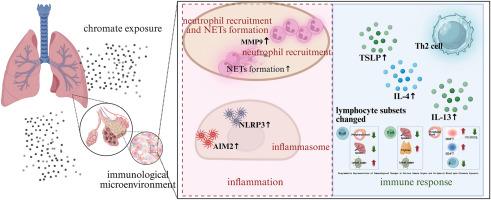六价铬暴露诱导免疫失调和肺组织中性粒细胞胞外陷阱形成。
IF 3.5
3区 医学
Q2 FOOD SCIENCE & TECHNOLOGY
引用次数: 0
摘要
六价铬[Cr(VI)]是一种已知的人类致癌物,与环境污染和健康风险有关。然而,其免疫毒性与炎症之间的关系仍然知之甚少。在本研究中,研究人员使用小鼠动态吸入暴露系统模拟Cr(VI)职业环境,并进行多器官免疫学评估以及肺组织炎症谱分析。观察到,吸入Cr(VI)暴露诱导了特定器官淋巴细胞亚群的选择性、时间依赖性变化,并伴有免疫相关细胞因子的显著上调。暴露引发肺组织中中性粒细胞胞外陷阱(NETs)的形成,NETs相关基因表达和炎症小体相关基因激活同时升高。免疫失调与炎症密切相关,其特征是NETs的形成和炎症小体的激活。此外,两周的恢复期显著改善了这些Cr(VI)诱导的免疫紊乱和炎症表现。这些发现为了解职业性Cr(VI)暴露中免疫功能障碍和炎症激活之间的相互作用提供了重要见解。本文章由计算机程序翻译,如有差异,请以英文原文为准。

Hexavalent chromium exposure induces immune dysregulation and lung tissue neutrophil extracellular traps formation
Hexavalent chromium [Cr(VI)] is a known human carcinogen that is associated with environmental pollution and health risks. However, the relationship between its immunotoxicity and inflammation is still poorly understood. In this study, researchers used a mouse dynamic inhalation exposure system to simulate Cr(VI) occupational environments and conducted multi-organ immunological assessment along with lung tissue inflammatory profiling. It was observed that Cr(VI) inhalation exposure induced selective, time-dependent variations in lymphocyte subsets across specific organs, accompanied by significant upregulation of immune-related cytokines. The exposure triggered neutrophil extracellular traps (NETs) formation in lung tissue with concurrent elevation in NETs-associated gene expression and inflammasome-related gene activation. Immune dysregulation demonstrated close correlation with inflammation characterized by NETs formation and inflammasome activation. Furthermore, a two-week recovery period resulted in significant amelioration of these Cr(VI)-induced immunological disturbances and inflammatory manifestations. These findings provide critical insights into the crosstalk between immune dysfunction and inflammatory activation in occupational Cr(VI) exposure.
求助全文
通过发布文献求助,成功后即可免费获取论文全文。
去求助
来源期刊

Food and Chemical Toxicology
工程技术-毒理学
CiteScore
10.90
自引率
4.70%
发文量
651
审稿时长
31 days
期刊介绍:
Food and Chemical Toxicology (FCT), an internationally renowned journal, that publishes original research articles and reviews on toxic effects, in animals and humans, of natural or synthetic chemicals occurring in the human environment with particular emphasis on food, drugs, and chemicals, including agricultural and industrial safety, and consumer product safety. Areas such as safety evaluation of novel foods and ingredients, biotechnologically-derived products, and nanomaterials are included in the scope of the journal. FCT also encourages submission of papers on inter-relationships between nutrition and toxicology and on in vitro techniques, particularly those fostering the 3 Rs.
The principal aim of the journal is to publish high impact, scholarly work and to serve as a multidisciplinary forum for research in toxicology. Papers submitted will be judged on the basis of scientific originality and contribution to the field, quality and subject matter. Studies should address at least one of the following:
-Adverse physiological/biochemical, or pathological changes induced by specific defined substances
-New techniques for assessing potential toxicity, including molecular biology
-Mechanisms underlying toxic phenomena
-Toxicological examinations of specific chemicals or consumer products, both those showing adverse effects and those demonstrating safety, that meet current standards of scientific acceptability.
Authors must clearly and briefly identify what novel toxic effect (s) or toxic mechanism (s) of the chemical are being reported and what their significance is in the abstract. Furthermore, sufficient doses should be included in order to provide information on NOAEL/LOAEL values.
 求助内容:
求助内容: 应助结果提醒方式:
应助结果提醒方式:


